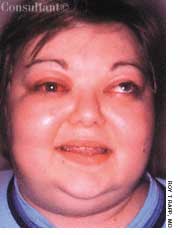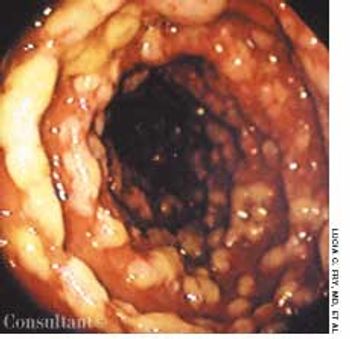
Even though highly active antiretroviral therapies and effective chemoprophylaxis are available, the exposure of HIV-infected patients to opportunistic pathogens remains a concern.


Even though highly active antiretroviral therapies and effective chemoprophylaxis are available, the exposure of HIV-infected patients to opportunistic pathogens remains a concern.

ABSTRACT: Most patients with nonspecific low back pain recover spontaneously within 4 to 6 weeks. Patients who resume their normal activities as soon as possible generally recover faster than those who stay in bed; analgesics speed recovery. Sciatica is usually caused by a herniated disk. However, if the patient has a demonstrable neurologic deficit, obtain plain radiographs to rule out tumor, spondylolisthesis, fracture, and infection. Administer high-dose intravenous corticosteroids immediately to patients with suspected epidural compression syndrome. Back pain in a patient with a history of cancer may indicate metastasis to the spine. If a cancer patient has new or aggravated symptoms, start corticosteroid therapy and order plain radiographs and MRI scans.

A previously healthy elderly woman reports that she has hadunilateral facial pain and crusting skin lesions for several days. She decides toseek medical care because of concomitant impaired visual acuity.

Several of my female patients have chronic itchy, burningvulvitis.

For 2 days, a 68-year-old woman had watery, yellowish diarrhea with mucus and left lower quadrant pain. Her medical history included hypertension, diabetes mellitus, and congestive heart failure (CHF); she had left the hospital 5 days earlier following treatment of an exacerbation of CHF with intravenous furosemide and sodium and fluid restriction. The patient was taking furosemide, lisinopril, and glipizide; she denied any recent antibiotic therapy.

A 63-year-old woman seeks evaluation of a persistent, rough, red area onthe dorsum of her left index finger. The lesion has been present for severalmonths. The patient’s manicurist is convinced it is a wart.

A 13-year-old boy presents with swelling of the left eyelidsthat started 12 hours earlier; the eyelashes are mattedwith yellow discharge. He does not wear contact lenses oreyeglasses and denies ocular trauma or foreign bodies. Hehas been nauseated and has vomited once; his motherattributes these symptoms to an antibiotic that was prescribed5 days earlier for a sinus infection. Medical historyis noncontributory; there is no family history of ocularproblems.

To facilitate removal of a subdermalforeign body from a patient’s hand,turn on an otoscope and lay it ona work surface, turn off the lights inthe room, and hold the hand againstthe otoscope.

A swollen, painful eyelid prompted a 39-year-old man to seek medical attention.The patient had noticed swelling, redness, and irritation in his left lateral eyebrowarea 2 days earlier. Upon awakening on the morning of his appointment,the left upper eyelid also felt full and tender and was drooping. A pointed drainingarea of purulent material had formed in the lateral brow region (not visiblehere). The patient was afebrile and denied any recent periorbital trauma. Hewas otherwise healthy; his only medication was a daily multivitamin.

A 37-year-old woman complains of “itchy bumps” that erupted just above herwaist 2 or 3 days earlier. She denies having had this condition in the past.The patient is otherwise healthy and takes no medications. An avid gardener,she claims to be able to identify and avoid poisonous plants.

After 5 weeks of undulating fever, weight loss, and night sweats, a 22-year-old man presented to the emergency department. He reported no significant medical history. The patient had recently completed a course of tetracycline followed by another of azithromycin for a presumed upper respiratory tract infection.

I read with interest Dr Virenda Parikh’s case of a young woman with extensiveanal condylomata acuminata (CONSULTANT, April 15, 2001, page 737).

My patient reports that erythemanodosum occurred when she took anoral contraceptive (OC) in the1990s.

The most appropriate choice is B. The history andphysical findings suggest that the patient may have afracture or contusion of the foot from trauma. There areno systemic signs that suggest an underlying infectious,chronic inflammatory, or oncologic process. A plain x-rayfilm of the foot is necessary to seewhether a fracture is present andwhether immobilization will be necessary.In the absence of fever and localerythema, infection appears unlikely,and a CBC count is unwarranted.

Children often resist examinations forotitis externa because of pain and tenderness.

ABSTRACT: A focused history taking and physical examination directed toward uncovering signs that suggest a serious underlying cause of low back pain are crucial. "Red flags" include pain that lasts more than 6 weeks; pain in persons younger than 18 years or older than 50 years; pain that radiates below the knee; a history of major trauma; poor rectal tone; constitutional symptoms; atypical pain (eg, that which occurs at night or that is unrelenting); the presence of a severe or rapidly progressive neurologic deficit; and a history of malignancy. These markers provide a cost-effective means of guiding your selection of laboratory and diagnostic imaging studies.

Foot ulcerations and infections are the leading cause of hospitalizationamong patients with diabetes; they occur in about15% of these patients. Given the rapidly increasing incidenceof diabetes, physicians can expect to see a growing numberof diabetic foot problems. Here, a group of experts, many ofwhom practice at the renowned Joslin-Beth Israel DeaconessFoot Center in Boston, offer guidance on all aspects of diabeticfoot care. The topics covered range from proven preventivestrategies to cutting-edge wound care techniques that drawon such new developments as growth factors and living skinequivalents. A detailed review of the pathophysiology of thediabetic foot is also included. The emphasis throughout is ona multidisciplinary approach that incorporates the servicesof diabetologists, podiatrists, orthopedic surgeons, orthotists,diabetic nurse educators, and others. Numerous black-and-whiteand color photographs, drawings, algorithms, and charts illustratethe text.

Although many patients with primary HSV-1 infection have no clinicalrecurrences, the failure to seroconvert occurs very seldom-inno more than 1% of patients.

Match each picture with the phrase below that best describes it. The organisms in these pictures might be microscopicor macroscopic, and they can be recovered from skin lesions or clothing by the patient and/or clinician.

Frequent hand washing is extremely important to help prevent nosocomial infections; however, compliance can be a problem. Encourage all staff members who have contact with patients to carry a bottle of quick-drying gel hand disinfectant with them.

A 72-year-old man slipped and fell backward in the bathroom, hitting hishead on the toilet seat; he suffered only minimal discomfort. The followingday, he presented with mild back pain and extensive bruising.

The parents of a 3-year-old boy bring him to your office after hecomplains of genital pain. The child is otherwise healthy; there is no knownhistory of trauma or difficult urination. The child has a low-grade fever and isin mild discomfort.

A 28-year-old man presents tothe emergency departmentwith high fever; progressive, severe,generalized, throbbing headache;blurred vision; and increasingconfusion. These symptoms started3 days earlier.

Which treatment approaches are effective in a woman who has persistent or refractory vaginal trichomoniasis? Should the male sex partner of a patient who has recurrent vulvovaginal candidiasis be treated? Answers to these and other questions can be found in the recently updated CDC guidelines on managing sexually transmitted diseases

The differential diagnosis of intrascrotal pathology includes a myriad of benign and malignant entities. Timely detection is imperative to reduce the morbidity associated with many of these disease processes.